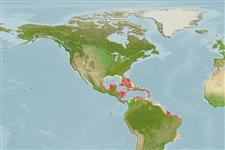Environment: milieu / climate zone / depth range / distribution range
Sinh thái học
Biển Cùng sống ở rạn san hô; không di cư; Mức độ sâu 0 - 10 m (Ref. 27000). Tropical; 33°N - 35°S, 98°W - 31°W
Western Atlantic: including southern Florida (USA), Bermuda, and northern Gulf of Mexico to Brazil.
Bộ gần gũi / Khối lượng (Trọng lượng) / Age
Maturity: Lm ? range ? - ? cm
Max length : 10.0 cm TL con đực/không giới tính; (Ref. 9710)
Các tia vây lưng cứng (tổng cộng) : 12; Các vây lưng mềm (tổng cộng) : 13 - 16; Tia cứng vây hậu môn: 2; Tia mềm vây hậu môn: 12 - 14. Caudal fin slightly forked, with rounded lobes. Dark blue or brown above, yellow below, without obvious narrow vertical lines. Dark spot near back of dorsal fin well above its base becomes smaller in larger fish (Ref. 26938).
Adults occur in seagrass beds, coral or rocky reefs and sandy areas. Also found around mangrove shores and sponge beds; less common on flourishing coral reefs (Ref. 26938). They remain within 50 cm from the substrate. Adults feed on algae, polychaetes, amphipods, foraminiferans and gastropods while juveniles feed on harpacticoid copepods, nemerteans and polychaetes (Ref. 9626). Oviparous, distinct pairing during breeding (Ref. 205). Eggs are demersal and adhere to the substrate (Ref. 205). Males guard and aerate the eggs (Ref. 205). Caught incidentally in traps and small-meshed beach nets (Ref. 5217).
Life cycle and mating behavior
Maturities | Sự tái sinh sản | Spawnings | Egg(s) | Fecundities | Ấu trùng
Oviparous, distinct pairing during breeding (Ref. 205). Males guard and aerate the eggs (Ref. 205). The eggs are deposited inside empty shells or under stones or shell (Ref. 39478).
Allen, G.R., 1991. Damselfishes of the world. Mergus Publishers, Melle, Germany. 271 p. (Ref. 7247)
IUCN Red List Status (Ref. 130435)
Threat to humans
Harmless
Human uses
Các nghề cá: Tính thương mại; Bể nuôi cá: Tính thương mại
Các công cụ
Special reports
Download XML
Các nguồn internet
Estimates based on models
Preferred temperature (Ref.
123201): 26.2 - 28.2, mean 27.5 °C (based on 586 cells).
Phylogenetic diversity index (Ref.
82804): PD
50 = 0.5000 [Uniqueness, from 0.5 = low to 2.0 = high].
Bayesian length-weight: a=0.01950 (0.01192 - 0.03189), b=2.95 (2.81 - 3.09), in cm total length, based on LWR estimates for this species & Genus-body shape (Ref.
93245).
Mức dinh dưỡng (Ref.
69278): 3.1 ±0.2 se; based on diet studies.
Thích nghi nhanh (Ref.
120179): Chiêù cao, thời gian nhân đôi của chủng quần tối thiểu là dưới 15 tháng (Preliminary K or Fecundity.).
Fishing Vulnerability (Ref.
59153): Low vulnerability (10 of 100).
Nutrients (Ref.
124155): Calcium = 124 [63, 196] mg/100g; Iron = 0.779 [0.462, 1.295] mg/100g; Protein = 18.4 [17.3, 19.5] %; Omega3 = 0.11 [0.06, 0.18] g/100g; Selenium = 18.8 [10.4, 36.2] μg/100g; VitaminA = 95.9 [28.1, 308.4] μg/100g; Zinc = 1.72 [1.15, 2.52] mg/100g (wet weight);
